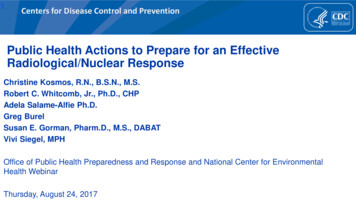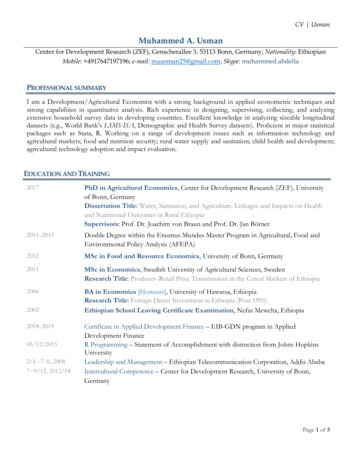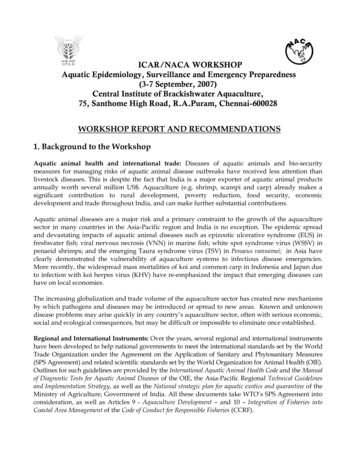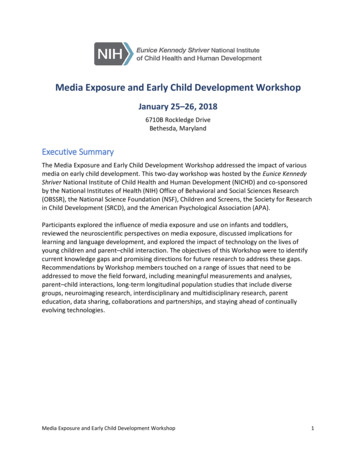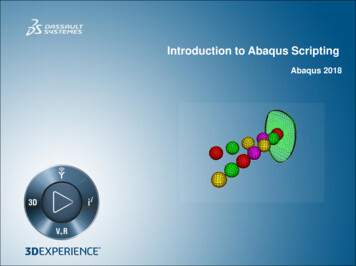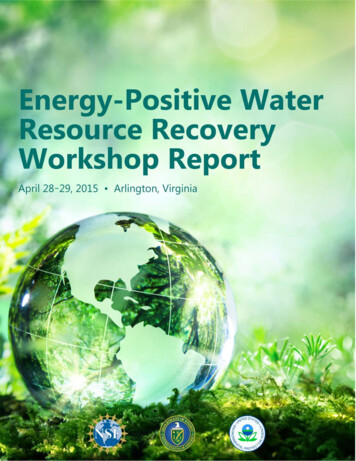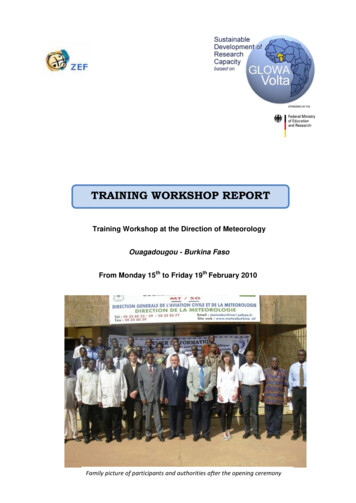
Transcription
TRAINING WORKSHOP REPORTTraining Workshop at the Direction of MeteorologyOuagadougou - Burkina FasoFrom Monday 15th to Friday 19th February 2010Family picture of participants and authorities after the opening ceremony
Table of Contents1. Introduction . 22. Location and period of the workshop . 23. Attendance . 34. Opening . 35. Workshop Sessions and Discussion . 46. Stakeholder Discussions RSSC project . 117. Closing . 148. Annex . 141. IntroductionThe goal of this workshop was the training of existing methodologies and tools forpredicting the onset of the rainy season for agricultural management.The training included the following topics:-The programming environment Matlab-The physically-based crop model CropSyst-A statistical method to estimate the onset of the rainy season in West Africa-Statistical models for predicting the onset of the rainy season-The procedure how to estimate the impact of climate change on cropproductivity in West AfricaFor the training communicators important workshop outcomes were:-Discussion with local stakeholder about priority research needs within theregion2. Location and period of the workshopThe workshop was held at the Direction of Meteorology (Ouagadougou, BurkinaFaso) from Monday 15th to Friday 19th February 2010.2
3. AttendanceThe invited institutions, which are listed below are mainly from research and datagathering institutes, apart from some exceptions belonging to water management orregulating bodies.1Direction de la Méteorologie2CROCO Burkina3Université de Ouagadougou / IGEDD4INERA5GREENHANDS Organization6IGEDD7CERPINEDD8IUCN/PACO9DRAHRH -Centre10IDR/UPB11IGB12DGRE4. OpeningThe overall goal of the training workshop was to introduce participants to existingmethods for estimating the onset of the rainy season under agricultural meaningfulaspects in West Africa. Additionally, the training gave insight in estimating theimpacts of the expected climate change on future agricultural productivity. Thepersons in charge were Dr. Patrick Laux and Greta Jäckel.The training workshop was opened at 9:30 a.m. with a welcome statement by theDirector of Meteorology, Mr. Garane Ali, followed by the statement of GVPCoordinator Prof. Dr. Karl Harmsen and an opening speech held by the GeneralDirector of Civil Aviation and Meteorology.Afterwards Prof. Karl Harmsen thanked GVP for organizing the workshops. Hementioned the importance of estimating onset of the rainy season especially for aridand semi-arid parts of Burkina Faso. Finally he wished all participants a good andsuccessful training workshop.3
The workshop was hosted by Dr. Patrick Laux and Greta Jäckel (both from theInstitute for Meteorology and Climate Research, IMK-IFU, Karlsruhe Institute ofTechnology, Germany), supported by Dr. Benjamin Kofi Nyarko and TheophileMbakop.5. Workshop Sessions and DiscussionMONDAY, FEBRUARY 15TH:Patrick Laux introduced the participants of the workshop into the topic of theestimation of the onset of the rainy season (ORS) and methods for its prediction byshowing the results of his PhD Thesis. Some highlights of his presentation were:-the definition of Onset Of Rainy Season (ORS)-statistical tools for predicting the ORS, i.e. linear discriminant analysis andlinear regression analysis-assessing the impacts of climate change on ORS datesThe following topics have been introduced to the participants during the Day 11.Onset of the rainy season (ORS) approach-ORS definition in the context of agriculture (planting date)-Literature: Approach of Stern et al., 19822.Fuzzy logic–based approach (modified version of Stern et al., 1981)3.Important questions:-Comparison of „traditional“ methods with „scientific“ methods (What can welearn (implement) from farmers?)Including/Translating farmers‘ criteria (e.g. flowering of trees, movement ofbats and ants) into computer-based expert systemImprovement of more specific modeling-How can we validate the calculated ORS dates?-How can we find the optimal criterions for estimating the ORS dates?4
Discussion Day 1:Question: What was the motivation of your PhD thesis?Answer: Since the 1980s farmers have been realizing a higher variability of rainfall.This also affects the onset of the rainy season. The motivation basically was to helpfarmers to decide when to plant in order to reduce crop yield losses.Question: Did the cessation of the rainy season play an important role in your PhDthesis?Answer: Yes, we also analyzed the cessation of the rains for the past and the future.For the future, for instance, we found that it is likely that the ORS dates will stronglydelay, but the cessation dates won’t delay that much. Consequently, the length of therainy season will decrease.TUESDAY, FEBRUARY 16th:Patrick made the recap of the presentations of day 1 which was essentially based onhow to define the ORS and to use the fuzzy logic-based ORS approach.The main focus of day 2 was set to:-The approach of ORS (Emphasizing and more clarification)-The forecasting and predicting of the ORS-Linear regression analysis and the ORS regression models for the region.An introduction to MATLAB was performed by Greta. The MATLAB software (trialversion) was handed over to the workshop participants for installation on theircomputers. First practical exercises were conducted after showing the advantages ofusing MATLAB and clarifying the algorithm, which should be used for determining theonset of the rainy season.Discussion Day 2:Question: Why do we have to learn how to program with Matlab? Why is itnecessary to add other functions?Answer: In this workshop we do not show you a nice graphical user interface (GUI).The routines for estimating the ORS are mainly functions. This keeps it more flexible.If you want to use them, or even modify them, you should know how to do that. Thereis the possibility to insert some other functions and variables for solving specificproblems. However, this is not a programming workshop, and you will only learn thebasics.5
Question: Has the ORS-model been validated with measured dates of the onset ofthe rainy season?Answer: There is no measured ORS data available. It is also difficult to get theinformation of the planting dates from the farmers. For this reason, it’s impossible tovalidate the ORS-approach in this way.But we will show you in this workshop how to perform crop modeling in order to findthe optimal planting dates (coinciding with the ORS dates).Question: Which information is contained in the term of the effective drought indexEDI?Answer: The drought index indicates water stress to plants based on observedrainfall. The calculation of the effective drought index can be realized byincorporating the effective precipitation and the mean effective precipitation for thewhole observation period. Furthermore the amount of the precipitation which isnecessary in order to obtain “normal” conditions is important for the calculation of theEDI. With the help of these parameters it’s possible to determine deviations from themean effective rainfall. Positive EDI indicate moist periods, negative EDI indicate dryconditions.Question: The approach for calculating the onset of the rainy season is quiteimportant. It’s based on different criterions. Are the criterions adjustable or are theyconventional?Answer: I explained the definition of Stern et al., 1981 to you in my presentation. Inthis publication they used fixed values for the criteria. At the same time all criterionshave to be fulfilled simultaneously. This limits the approach. Therefore, we used afuzzy logic-based approach to find the optimal solutions for these criteria. Theystrongly depend on the region (station) and the crops. Using a plant growth model weare able to adjust these criteria operationally. It was possible to optimize the fuzzylogic criteria with the help of a plant physiological model.Question: I would like to know, whether this approach (linear regression analysis) isexamined?Answer: Yes, we validated this approach using jack-knife validation and the resultswere satisfying. This validation was done with data in a period from 1961 to 2001 forthe Volta Basin.6
Question: To what timeframe after 2001 can this approach be applied to?Answer: This approach could be applied for each time period you want, dependingthe availability of precipitation data. However, it should not be used for forecastingpurposes. It is recommended to use it for the ongoing season.Question: I have a question concerning the regions with similar precipitation. Whichrelation is between the prediction of the ORS of a station of a certain region, and astation of another region, if the variability of the rainfall is evident? You can see thisfor example at the stations Bobo and Fada, which are in different regions: there is asignificant difference for the ORS of 30 days.Answer: It’s difficult to answer this question precisely. In order to predict the onset ofthe rainy season for the Volta Basin I grouped stations with similar temporal rainfallcharacteristics to 5 different regions I think it’s more favorable to use regions insteadof stations due to the lower variability of the regions. Theoretically, the LRA approachcould be applied for stations, too.WEDNESDAY, FEBRUARY 17.At day 3, Patrick started with the recap of day 2.The recap was followed by an introduction to the crop yield model CropSyst. Thefollowing topics were covered:-Introduction to different modules of CropSyst (Location, Weather, Soil,Management )-Exercise: Creation of location file for each Pixel of Upper-East region-First modeling exercises (manually) for 1979-2001 using different plantingdates (as only variable) to estimate impact of planting date on crop yield.THURSDAY, FEBRUARY 18thAs usual, day 4 started with the recap of day 3.Greta Jäckel presented the results of her master thesis with the topic “Impact of theplanting date on crop yield – a case study of Cameroon”She demonstrated that for Cameroon, the application of ORS-approach is favourablein relation to fixed traditional planting dates. She highlighted the effect of agriculturalmanagement (planting date) on attainable crop yields.7
Discussion Day 4:Question: I would like to know whether the results of the simulations are reliable (forthe Volta region)?Answer: I want to point out that this model is not calibrated yet for the Volta Basin. Ijust want to show you the procedure, that you have the technical background forstarting such simulations. The results we showed are valid for Cameroon.Question: Is there a correction factor within CropSyst?Answer: There is no correction factor, which could be set in the model CropSyst.The data (e.g. precipitation, temperature) has to be corrected before starting thesimulations.Question: Is it possible to make a forecast within the coupled ORS-algorithm?Answer: In order to make a forecast within the coupled ORS-algorithm a 30-dayforecast for the third criterion is necessary. This drought criterion (false start criterion)could be used for the past or ex-post but unfortunately not for the future. A way out ofthis misery is to leave out this criterion and to consider a-priori values for the falsestart probabilities (as shown in my PhD thesis).Question: Which is the optimal planting date to achieve maximum crop yieldsaccording to Gretas assumption?Answer: It’s not easy to answer this question. The optimal planting date depends onthe location and the crop and varies inter-annually. The date depends on the optimalvalues for the membership functions. In order to get these parameters for the VoltaBasin, the crop model has to be calibrated first.Question: I think the farmers will be really interested in this approach if the simulatedcrop yield exceeds their actual yields.Answer: Yes, I agree. However, you cannot compare the results of the simulationsdirectly with the actual measured yields. There is a large uncertainty of the measuredyields, but also uncertainties due to the crop growth model, the input data, thedownscaling approach etc.Additionally, field studies are necessary to prove if this approach is superior totraditional methods (planting dates). So far, this is just a computer simulation.8
Question: Is there a tool in the model, which considers exogenous factors (e.g.convective rainfall ) and corrects it automatically?Answer: No, there are no tools and correction factors within the model structure. Theinput data has to be corrected before starting the simulations.Question: Which should be the best time to implement this approach into fieldstudies?Answer: Unfortunately I can’t answer to this question. For these decisions anagronomist is necessary.Question: Why did you choose the crops maize and groundnut?Answer: We chose maize, because of its important role as cash and staple crop inWest Africa. Furthermore we decided to choose maize, which is a C4-plant, andgroundnut, which is a C3-plant, because we want to analyze the impact of CC andthe direct CO2 fertilization effect on different plant photosynthesis types.Question: How did you calibrate the crop model?Answer: We used AGRISTAT data for the calibration of the model CropSyst forCameroon. Unfortunately we only had 5 years of actual crop yieldsFor the Volta Basin this calibration is not yet done. We used for the workshopsimulations for Burkina Faso a non-calibrated model. This is why the results of oursimulation are not reliable.Question: The effects of the climate change (for the components precipitation andtemperature) were presented in Gretas presentation for Cameroon. Are there similareffects of the climate change for the Volta Basin possible?Answer: This is a very difficult question. It is possible, that the effects of the climatechange are similar to the effects simulated for Cameroon, but it’s not sure.Precipitation for example is subjected to a high spatial variability. An increasing ordecreasing trend is possible. In Greta’s presentation you could even realize that thedifferent GCMs predict different signals: one GCM shows an increasing trend, theother shows a decreasing trend of precipitation.9
FRIDAY, FEBRUARY 12Day 5 started with a short recap of day 4 followed by the presentation of MoussaWAONGO from the Burkina Faso Met services. His presentation was about thepotential applicability of the workshop material in practice.After his presentation, a discussion was opened. The highlights are listed below:Discussion Day 5:Question: Which are the most important parameters which are integrated in thissoftware DHC?Answer: It’s possible to calculate the crop yield and to include the vegetation, the soilproperties as well as all current trends of the climate change.But unfortunately it is impossible for us to make simulations or to determine the datebased on existing data. This requires collaboration between institutions for betterperformance in terms of resultsQuestion: How to get information concerning the actual data of the onset of the rainyseason?Answer: The actual date of the onset of the rainy season of the last year is publishedat the beginning of each year. This information is given to the directories ofagriculture for each region, which pass it to the local farmers.Question: You mentioned aspects of prediction. What’s the most important factor foryou: short-,mid- or long-term?Answer: We are more interested in short-term predictions.Question: Do you have any information concerning the traditional planting rules ofthe farmers? Did you evaluate the reliability?Answer: A common planting rule is sowing after the migration of the birds. We can’tevaluate this assumption, because we’re no farmers. Furthermore some farmersincorporate these factors, some farmers not. I think you can’t say that thesetraditional planting rules are reliable.Question: Does the definition after STERN et al. calculate the date onset of the rainyseason or the date of planting?10
Answer: It depends how you define the onset of the rainy season. In this work Idefined the onset of the rainy season in an agronomical way: that means the datewhen the rainy season starts, is the optimal date for planting.6. Stakeholder Discussions RSSC projectA stakeholder discussion also followed, lead by Patrick. Its goal was to identifypriority research needs in the context of a new project RCCS. The major questions tobe answered were:-Where to focus (research questions)?-What to add/change?The results of the discussions were:1. ClimateResearch questions/needs:-Carbon Sesquestion, organic toxic components-Improving adaptation indigenous strategies CC-Evaluation Adaptation strategies (CC)-Optimization and automation weather observation network-Analysis variability and prediction extreme events (dry spells, temperature,rainfall, wind)-Analysis and modeling of weather conditions on urban pollution-Cloud seeding-Impact squall lines on infrastructure (velocity,intensity)-Impact CC and variability on weather sensitive diseases-Adapting regional models for Sahelian regions (model development)-Impact weather on energy production (solar.)2. Natural Resources Management & Food Security (Agriculture)Research questions/needs:- Onset of the Rainy Season- Impact CC on Agric.11
- Cropping techniques (CC)- Reduction aET- Tillage conservation techniques (agroecolog. zones)- Identification of suitable regions for agri. (CC)- Evaluation adaptation strategies (CC)- Impact CC and variability on weather sensitive pests3. WaterResearch questions/needs:- Reduction Evaporation of surface water and siltation (Development Techniques)- Flood control – construction dams, dykes- Early warning systems (models)- Evaluation adaptation strategies (CC)- Economic study water reservoirs in the framework of market gardening4. SoilResearch questions/needs:- Sequester carbon- Evaluation adaptation strategies (CC)- Technical improvement geothermy- Characterization & monitoring soil (regional)- Spatial characterisation albedo5. Social aspectsResearch questions/needs:- Decentralization and land issues6. Specific needs for agriculture service-Adapting models (GCMs, regional models)-Soil moisture information-Type crop-Actual ET-Extremes (dry spells, extreme humidity) accounting for stage of cropdevelopment12
7. Collaboration - data sharingINERA (agronomic data)- MetServices (weather data)- (Geographic Institute BF)8. Collaboration – field studies- Evaluation ORS definitionsFocus: Research ORSQ: Are you interested that the ORS topic will be continued? How can your institutioncontribute to this research? What can be modified (improved)? Participants gavetheir opinion, comments and suggestions.a) Are you interested to be involved in the research concerning thesubject “Onset of the rainy season”?-All participants of the workshops are definitively interested tocollaborate in this field.-Adaption of the topic to our subject (agricultural meteorology)-Documentation of MATLAB in French-Procurement and Management data-Explanation of the basicsb) In which way can your institution contribute for the research onthe topic “onset of the rainy season”?- Supervision and provision of master and PhD theses in this topic- Sharing input data (different spatial and temporal distribution) andresults of simulations (support and suggestions)- Calibration of the new models- Keeping contact with resident farmers- Characterization of soil properties and compositionc) Other suggestions and comments- Cropsyst could be applied for our purposes- Sponsoring scholarships for e.g. PhD candidates- Find more possibilities for the calibration of this model- Absorption of costs (accommodation, journey) for the people of the ruralareas13
- Adaption of training to the respective educational level- Continuing the work with the model CropSyst, in order to calibrate themodel and run simulations- Training of related topics (e.g. workshops)- Possibility to get more MATLAB licenses- Consideration of political matters in the models7. ClosingM. Ali GARANE, Director of Meteorology thanked all the participants and thelecturers. He officially closed the workshop around 2:00 p.m.8. AnnexORS –WS list of participantsNo NameInstitutionDirection1ZONGO T PierreDIASSO U. JacquesWAONGO MoussaSIA CyriaqueZ rologieDirectionsiacyriaque@yahoo.frdela5BAZIE Jean MarcMéteorologiejmcontact@hotmail.com6COMPAORE W. FabrisCROCO Burkinafawaco84@yahoo.frUniversitéde7Dr. YONLI ArsèneOuaga/IGEDDyarsene@hotmail.com8Dr. COMPAORE HalidouINERAhalidou21@yahoo.frGREENHANDS9SOMTINDA Sondo EloiOrganizationsomson4@yahoo.fr10 HIEN PlacideIGEDDhpbeyonde@yahoo.fr11 BASSOLE K. Jean MarieCERPINEDDbassolejm@yahoo.fr12 BASSOLE AndréCERPINEDDabassole@fasonet.bf14
Direction13 NACOULMA GuillaumelaMéteorologieDirection14 COMPAORE K. onablasse c@hotmail.comdela15 YAKA D. PascalMéteorologiepascal yaka@yahoo.fr16 BALIMA AmadouIUCN/PACOamadou.balima@iucn.org17 SERME IdrissDRAHRH -Centresermeidriss@yahoo.fr18 BACYE BernardIDR/UPBbbacyo@gmail.com19 MBAKOP ThéophileGlowa Consultantteocordell@hotmail.comDirectiondela20 SANFO B. JudithMéteorologiesanfo b@yahoo.com21 BAKO FernandIGBbakoferd@yahoo.fr22 BADO IgorGlowabazoinigor@yahoo.com23 OUEDRAOGO MoustaphaDGREouemus@yahoo.fr24 NACOULMA PascalDGRElocoupascal@hotmail.com15
16
17
Director of Civil Aviation and Meteorology. Afterwards Prof. Karl Harmsen thanked GVP for organizing the workshops. He mentioned the importance of estimating onset of the rainy season especially for arid and semi-arid parts of Burkina Faso. Finally he wished all participants a good and successful training workshop.


